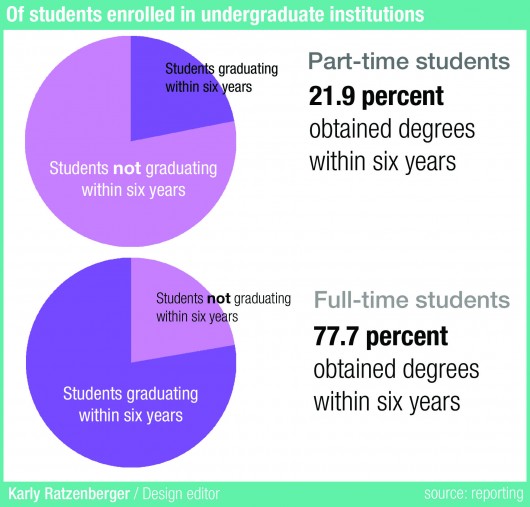Part-time student Chelsea Phelps is planning to graduate in the next year or two, but with a child on the way and problems scheduling classes around her jobs, she isn’t sure she’ll be able to do it.
Phelps, a part-time fourth-year student at Ohio State’s Marion campus, is studying social work and she chose to attend school part-time for one main reason.
“I became a part-time student due to financial aid problems, and since I’m paying out of pocket, I could only maintain part-time,” Phelps, 22, said.
This is Phelp’s first year as a part-time student, and she said scheduling classes last semester was particularly difficult.
“Last semester I was living in Upper Sandusky (about 22 miles from OSU-Marion), and I was working third-shift, so it was hard finding classes that would allow me to sleep after work or give me enough time to get things done before work,” Phelps said.
OSU had 5,300 part-time undergraduate students across all of its campuses enrolled during Fall Semester 2013, and according to a recent study by the National Student Clearinghouse, that demographic of students is nationally the least likely group to graduate within six years.
The study, released in December, looked at more than 2.3 million first-time students enrolled in both two- and four-year undergraduate institutions in fall 2007 and found that among those students, 21.9 percent of part-time students completed their degrees as 77.7 percent of full-time students completed theirs.
Information was not immediately available regarding the graduation rates of part-time students at OSU, university spokesman Gary Lewis said in an email.
“(That information) would take a significant amount of time to research and process the data,” Lewis said.
There is, however, information about the amount of credit hours those students are enrolled in.
To be considered part-time, students must be taking less than 12 credit hours. On average, part-time students at OSU took 6.46 credit hours during Fall Semester, according to OSU’s 15th Day Enrollment Report.
The report looks at enrollment for OSU’s Columbus campus and the university as a whole, based on the enrollment on the 15th day of the term, according to the Enrollment Services website.
In 2003, there were nearly 3,000 part-time undergraduate students enrolled across OSU’s campuses, according to a 10-year enrollment report.
In the same time frame, total enrollment of part-time and full-time students at all campuses has increased by about 5,700 students.
While Phelps took six credits hours last semester, this semester she’s taking three.
“I only need major courses, and my plan of attack is to stay focused and not to fall behind again,” she said.
Kaitlyn Robis, a third-year in anthropology and zoology at OSU’s Columbus campus who is enrolled as a part-time student for the first time this semester, said she plans to graduate in either spring or fall 2015.
Robis also noted problems with financial aid as her reason for becoming a part-time student, but said she wants to go back to full-time next fall.
In the meantime, Robis said she’s doing what she can to stay on track to graduate.
“I will still be taking May semester classes (in Columbus) and (summer) classes at Stone Lab, so it’s more like spreading out credit hours,” she said.
Maymester was developed as a result of OSU’s conversion to semesters in 2012. The four-week long May Session was combined with a seven-week long Summer Session to comprise Summer Term. OSU offered students up to three free credit hours during May Session to encourage enrollment during the 2013 term, and officials have said the university will do the same for 2014.
Students who enrolled in Maymester were still responsible for paying student fees, including Central Ohio Transit Authority and activity fees.
Robis said one problem she’s faced as a part-time student is not getting all of the benefits of being full-time.
“Full-time students get three free credit hours of tuition for May semester. I won’t be able to get those free hours,” she said.
Class offerings are also a matter of concern during Maymester for Robis.
“I want to take classes for my major, but not much will be offered, so I’ll probably end up taking any leftover GECs,” she said.
Robis said she also works between 23 and 28 hours a week and is currently looking for a second job.
Despite complicated scheduling and outside commitments, Robis said she’s determined to work hard toward a better future.
“I feel like if I drop out of school to save up by working, then I’ll have trouble going back and getting started again, so it seems like a better idea, to me, to stay in school more consistently,” she said.



